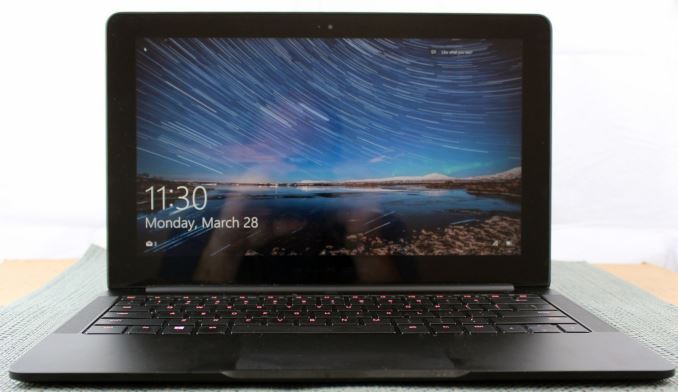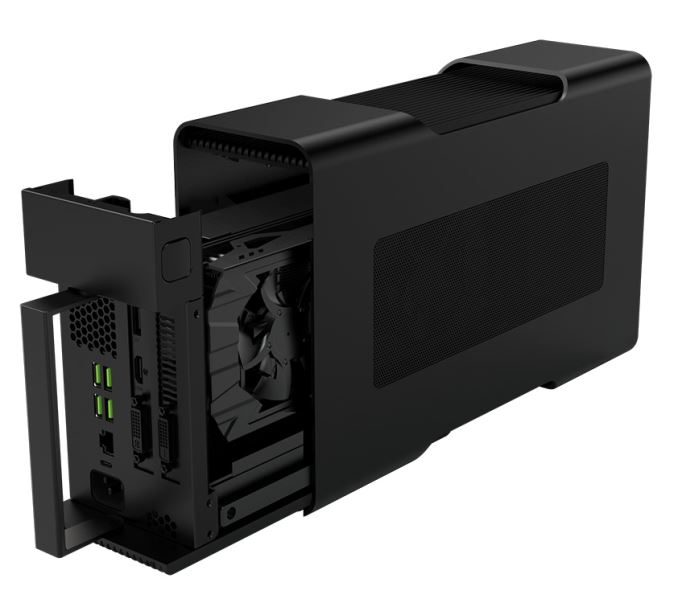The Razer Blade Stealth Review: Razer Takes On The Ultrabook
by Brett Howse on March 29, 2016 8:00 AM EST- Posted in
- Laptops
- Razer
- Skylake
- Razer Blade Stealth
- eGFX
- Razer Core
- Skylake-U

Razer has traditionally been a company focused on gaming. In fact, their tagline is “For Gamers. By Gamers.” So when Razer announced at CES that they were building an Ultrabook – a product category whose size and power limitations are typically the antithesis of gaming – it was a bit surprising. Razer decided it was time to branch out into more of the mainstream of PC hardware, but of course with the Razer twists they are known for. The Razer Blade Stealth is not your typical Ultrabook, and one of the biggest twists of all is that it can be docked to a desktop GPU to actually enable gaming.
The Razer Blade Stealth is a stand-alone product, so we can’t assume everyone that buys it will purchase the first Thunderbolt 3 external graphics dock which Razer developed for it, but the Razer Core is certainly an interesting addition to the notebook. We’ll take a closer look at that in the future, but for now the Razer Blade Stealth must be a capable device on its own merits.
When you talk about value, it doesn’t mean low cost. The Razer Blade Stealth is not an inexpensive notebook, but when you look at what kind of technology is inside, the value proposition starts to have some merit. Razer, has traditionally offered the high quality Razer Blade 14, but it was never as inexpensive as the competition. With the Razer Blade Stealth, as well as the new pricing on the Razer Blade 14, the company appears to want to reach a much wider audience.
The 12.5-inch Razer Blade Stealth (which for the sake of brevity I'll refer to as simply the Stealth) starts at $999, which makes it one of the most inexpensive Ultrabooks available with a Core i7 processor. There are not different models with Core i3/i5/i7, but instead every Stealth ships with a Core i7-6500U. The Dell XPS 13, as an example, only offers the i7 on the most expensive models, which are over $600 more expensive. Instead of processor based models, Razer is segmenting their models by offering two different displays: a base offering with a sRGB QHD 2560x1440 panel, and a higher-end model with an Adobe RGB UHD 3840x2160 panel. There are also three storage offerings, with 128 GB and 256 GB available on the QHD model, and 256 GB and 512 GB on the UHD version. All storage is provided by Samsung’s PM951, which is a PCIe 3.0 x4 NVMe drive with TLC NAND.
| Razer Blade Stealth | |||||
| QHD | UHD (As Tested) | ||||
| CPU | Intel Core i7-6500U Dual-Core with Hyperthreading 2.5-3.1 GHz, 4MB Cache, 15W TDP |
||||
| GPU | Intel HD 520 300-1050MHz, 24 Eus |
||||
| Memory | 8GB LPDDR3-1866 Dual-channel | ||||
| Display | 12.5-inch IGZO 2560x1440 sRGB with touch |
12.5-inch IGZO 3840x2160 Adobe RGB with touch |
|||
| Storage | 128-256GB PCIe NVMe Samsung PM951 |
256-512GB PCIe NVMe Samsung PM951 |
|||
| I/O | USB 3.1 Type-C x 1 with Thunderbolt 3 USB 3.0 Type-A x 2 Headset jack 2.0MP Webcam HDMI |
||||
| Dimensions | 321 x 206 x 13.1 mm 12.6 x 8.1 x 0.52 inches |
||||
| Weight | 1.25 kg / 2.75 lbs | ||||
| Battery | 45 Wh, 45 W AC Adapter (USB-C) | ||||
| Keyboard | Chroma anti-ghosting keyboard with individually backlit keys | ||||
| Wireless | Killer 1535 802.11ac 2x2:2 with Bluetooth 4.1 |
||||
| Price | $999.99-$1199.99 | $1399.99-$1599.99 | |||
Looking at the rest of the product, we can see that Razer has decided to move to Killer’s networking solution, which fits in more with their gaming aspect, but the latest Killer products have been reliable in my experience too, so I think this is not a bad move. Razer offers a single Thunderbolt 3 port over USB-C, which doubles as the charging port for the laptop. When docked to the Razer Core, this is a single cable docking solution which does the external graphics and I/O as well as laptop charging. In addition, there are two USB 3.0 ports on the laptop, along with an HDMI port, but there is no SD card reader.
The 8 GB of memory is really the minimum that would be acceptable in a 2016 Ultrabook, and there’s no option for more memory which is unfortunate. But other than that, Razer offers quite a bit of notebook for the $999 starting price. Though personally I suspect that $1199 is going to be the sweet spot, as it offers 256 GB of storage and the QHD display.











66 Comments
View All Comments
bug77 - Wednesday, March 30, 2016 - link
Hear, hear!My desktop has it's place and is the only device I game on (save for PvZ2 on my old tablet).
lmcd - Tuesday, March 29, 2016 - link
While the battery life isn't mind-blowing, I wish the storage tiers went 900-1100-1300-1500. Six hour battery life, while bad by comparison, is still more than the average person's working time away from the desk and wouldn't limit most of the people interested in this.jcbenten - Tuesday, March 29, 2016 - link
The thick bezel makes it look old. After seeing the XPS and Surface Book I could not stand to look at this screen.nagi603 - Tuesday, March 29, 2016 - link
Yeah, that bezel looks thicker than that of my old 2004 gaming laptop...Naql99 - Tuesday, March 29, 2016 - link
I bought one of these for my son. First power adapter was defective out of the box. The usb-c connector would not 'snap' into place. Returned it and the replacement unit broke in about 2 weeks when the tip fell out of the end of the cable. I assumed my son was at fault, so I purchased another for the princely sum of $140. The tip fell out of that one within 3 days. Razer refused to replacement. Well, sorry, but cannot afford to keep shelling out $140 a pop for charging bricks and they clearly have a build quality defect. Sure, the colored backlit keys are pretty, but Razer quality is sub-par and their support let me down. We ended up buying an Innergie charger for $40 that works, even though Razer support warned me that using it instead of their crappy $140 chargers would 'void my warranty'. Ok, your warranty isn't worth squat. May I recommend the dell xps precision laptops which are also eGPU capable. As for the Core, it does not even offer a thunderbolt pass-thru, so how can that be considered an actual docking unit. There will be other eGPU solutions soon. I would wait. Buyer beware. Out of the two months my kid has had it, he's only been able to use it for maybe 2 weeks.DanNeely - Tuesday, March 29, 2016 - link
It has a bunch of USB ports, an ethernet port, and a bunch of video out ports. That looks like a standard docking station to me. If I were to criticize it for anything, a lack of audio ports would be my biggest grumble.Not including TBs optional passthrough feature was probably a deliberate decision to limit competition for bandwidth the GPU needs. An x4 PCIe connection is enough that most games will run at almost full speed; only an x1 will strangle a large fraction of them. Even with just USB+ethernet you could end up oversaturating TB3: 32gb for PCIe, + 4x 5gb for USB3 + 1gb for ethernet is 53 gb vs TB3's 40gb. In practice that's unlikely to be a major concern; not least because 1 or more of the USB ports would typically be filled with low bandwidth devices (keyboard, mouse, usb headset); and USB3 devices capable of maxing the bus speed for sustained periods of time are relatively uncommon. Chaining a second high bandwidth TB device OTOH could be problematic; giving it half the total bandwidth would hurt the GPU in a significant number of games. Things that would fall under the category of "clever^H^H^H^H^H^Hstupid user tricks" like chaining a TB3 monitor and having it run off the laptops IGP (either due to misconfiguration, or not having video pass through support for the docs GPU due to cost or hardware limitations) could also end up burning people.
IMO with GPUs in the mix any sort of daisy chaining would need to wait for a future standard that supports at least 8x PCIe.
Naql99 - Tuesday, March 29, 2016 - link
I see your point, but I have a significant number of thunderbolt devices. I need to be able to hook up my external disks. In general, it is frustrating that there are so many thunderbolt devices that insist on being the the last device in the chain. In any case, I would have purchased the Core, if not for the support/wuality issues noted above.jsntech - Tuesday, March 29, 2016 - link
Razer has made enough missteps for me (Synapse 2.0, numerous failed devices which were very gently used) that despite the decent form factor competing pretty nicely with rMBP 13 and such, I won't even consider it (not to mention 16:9 is *especially* poorly suited on a 12.5" display).jsntech - Tuesday, March 29, 2016 - link
Er, the MB is probably a better comparison.TheinsanegamerN - Tuesday, March 29, 2016 - link
For that price, I would have expected for them to use the i7 6560u with the iris 540 gpu, and have better battery life. This thing is just a normal uber expensive ultrabook without the dock, at least with iris it could stand on its own a bit.